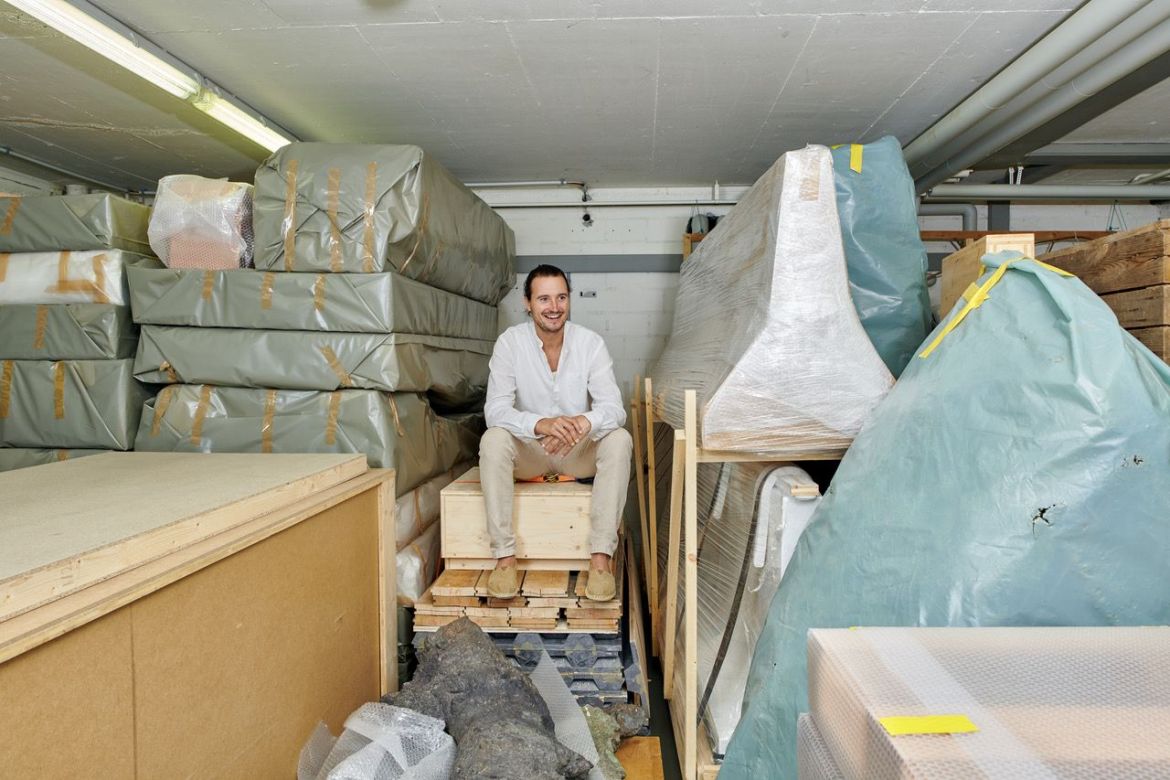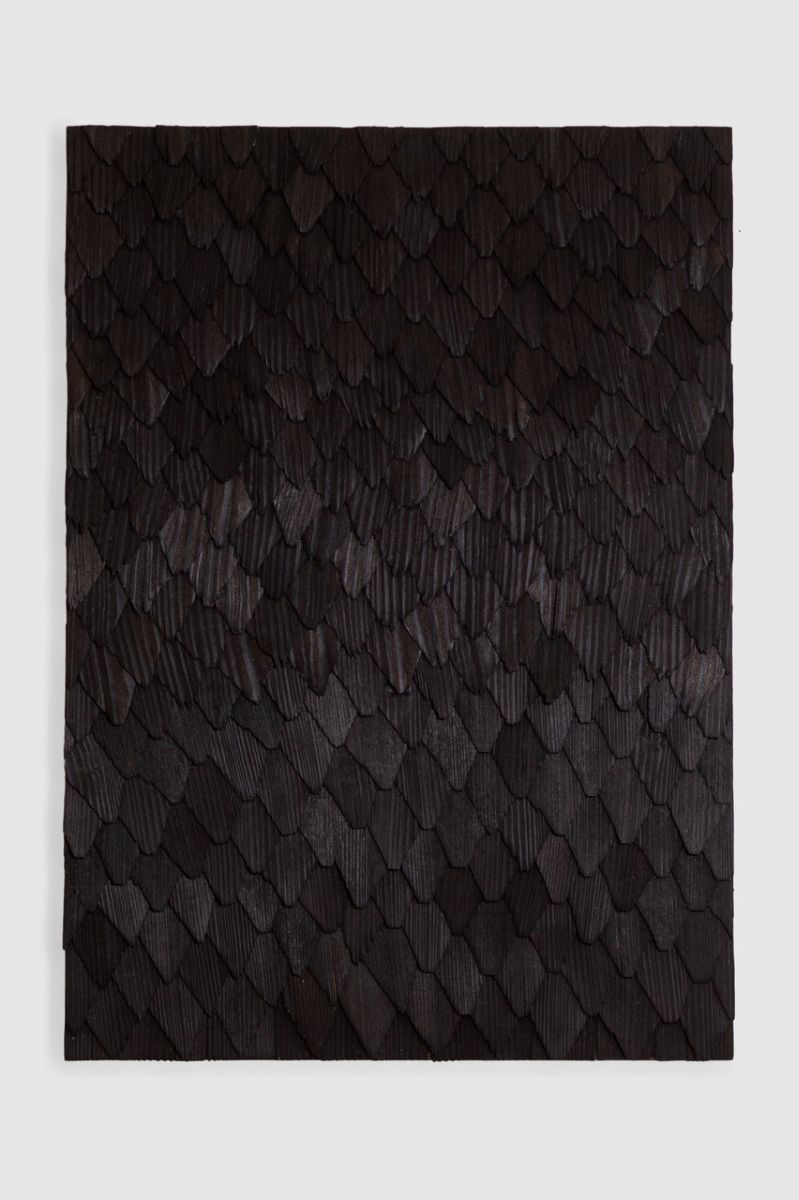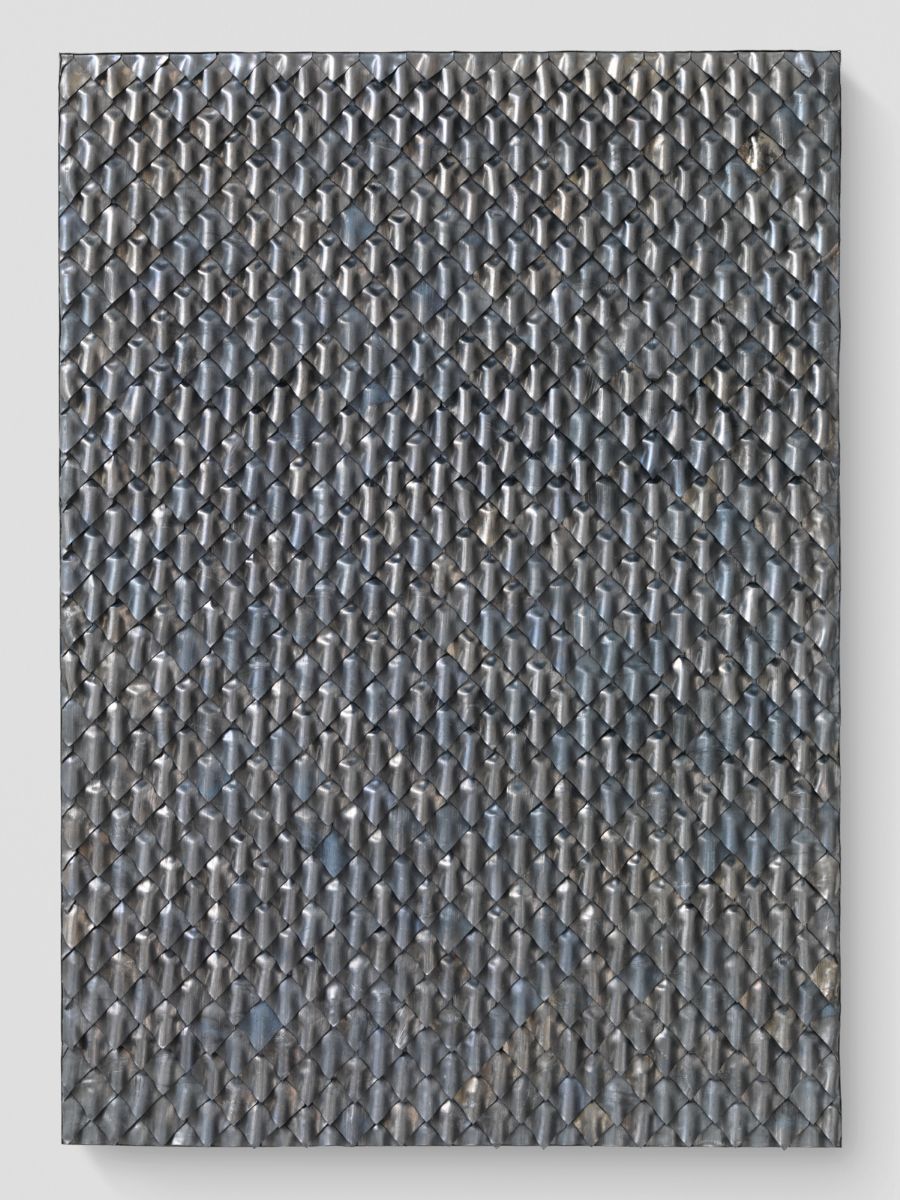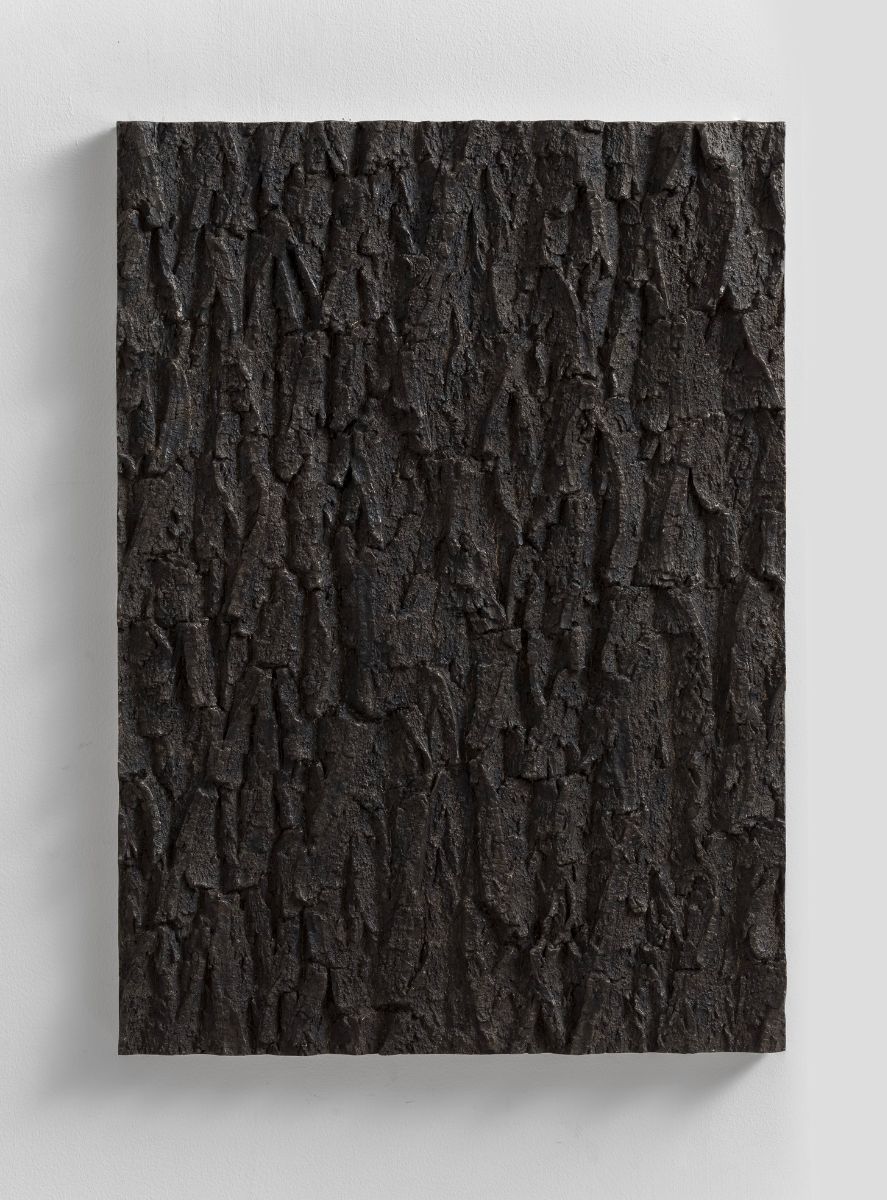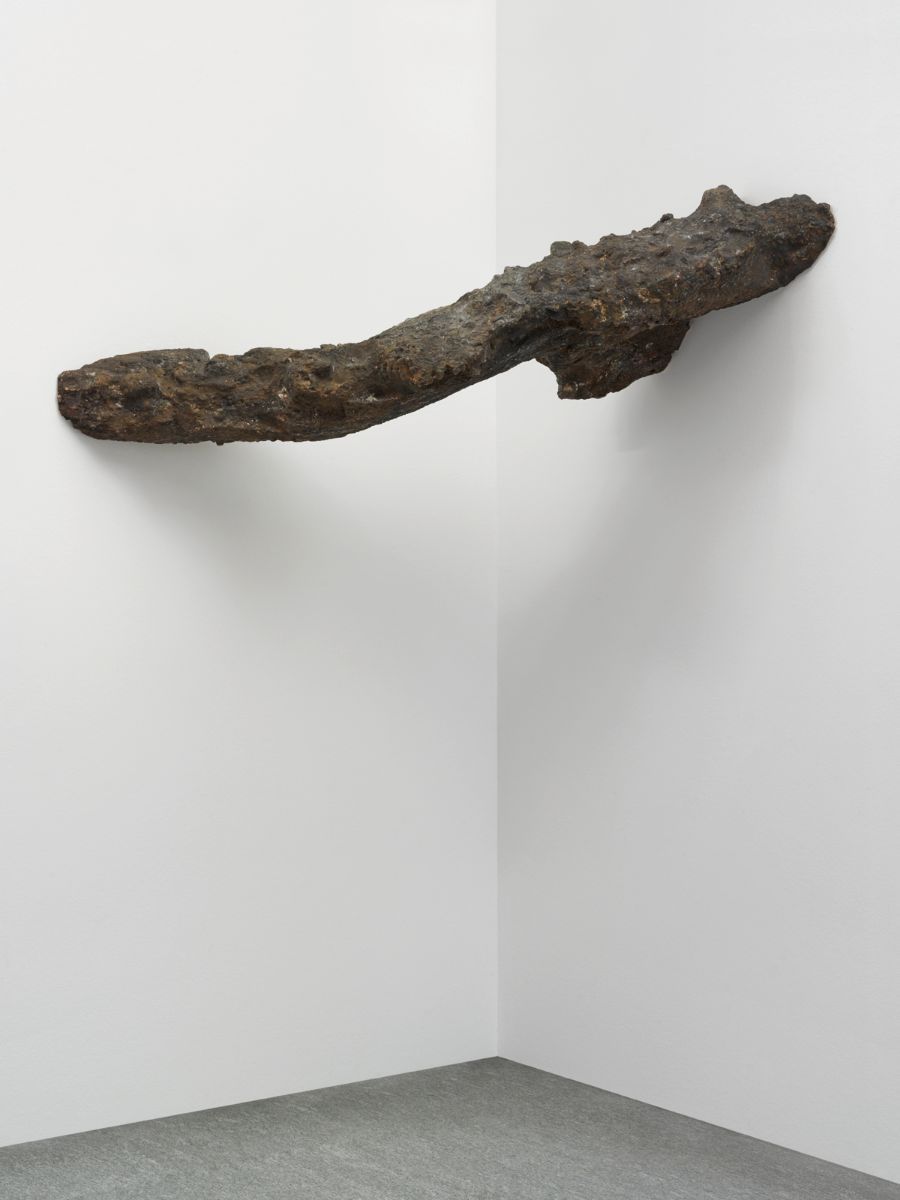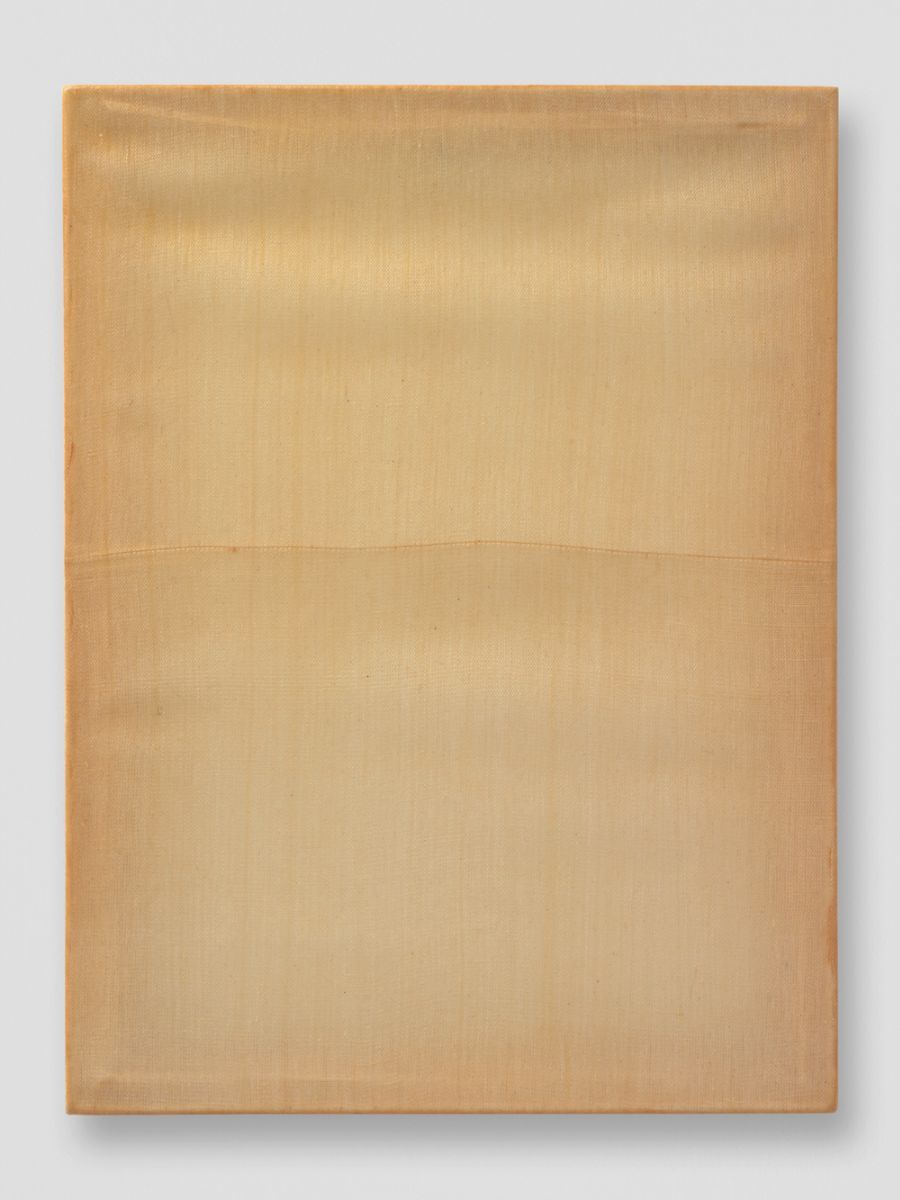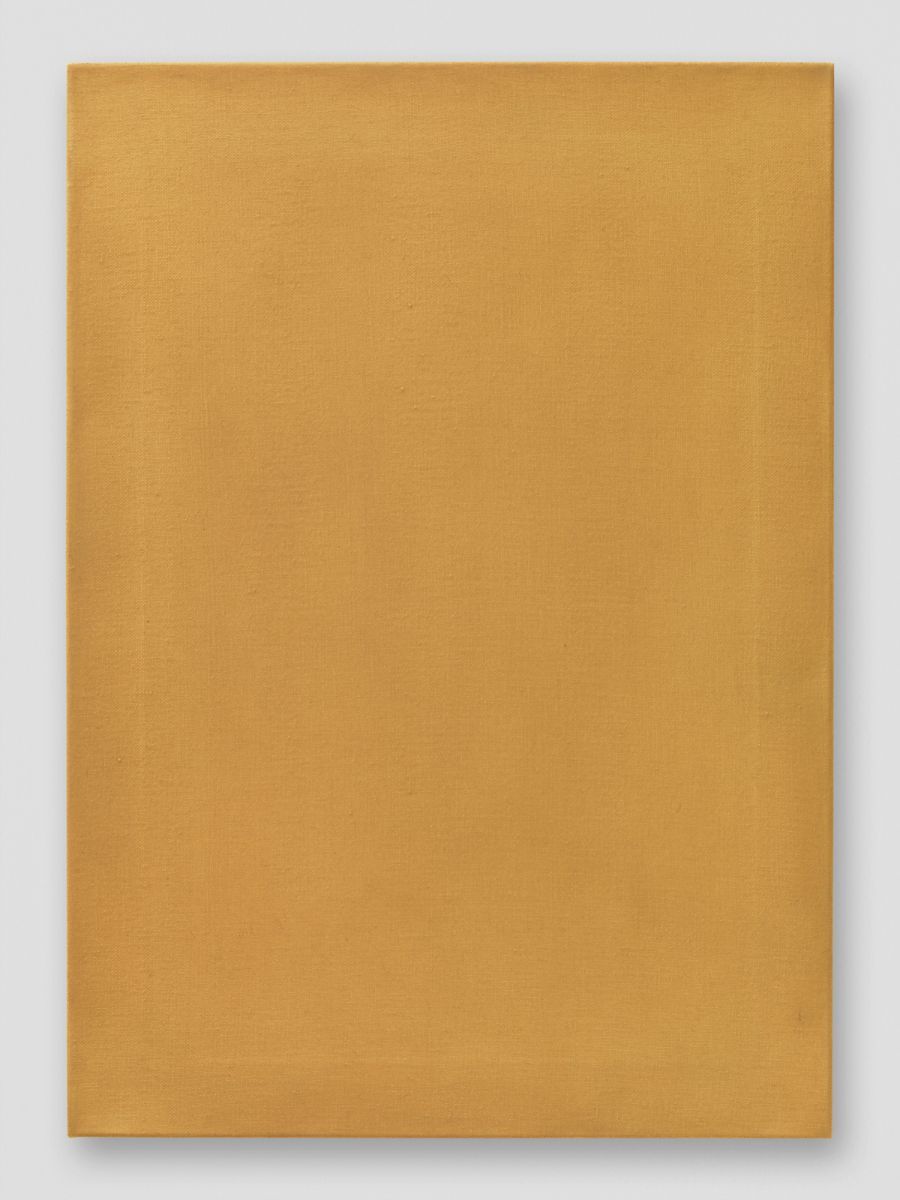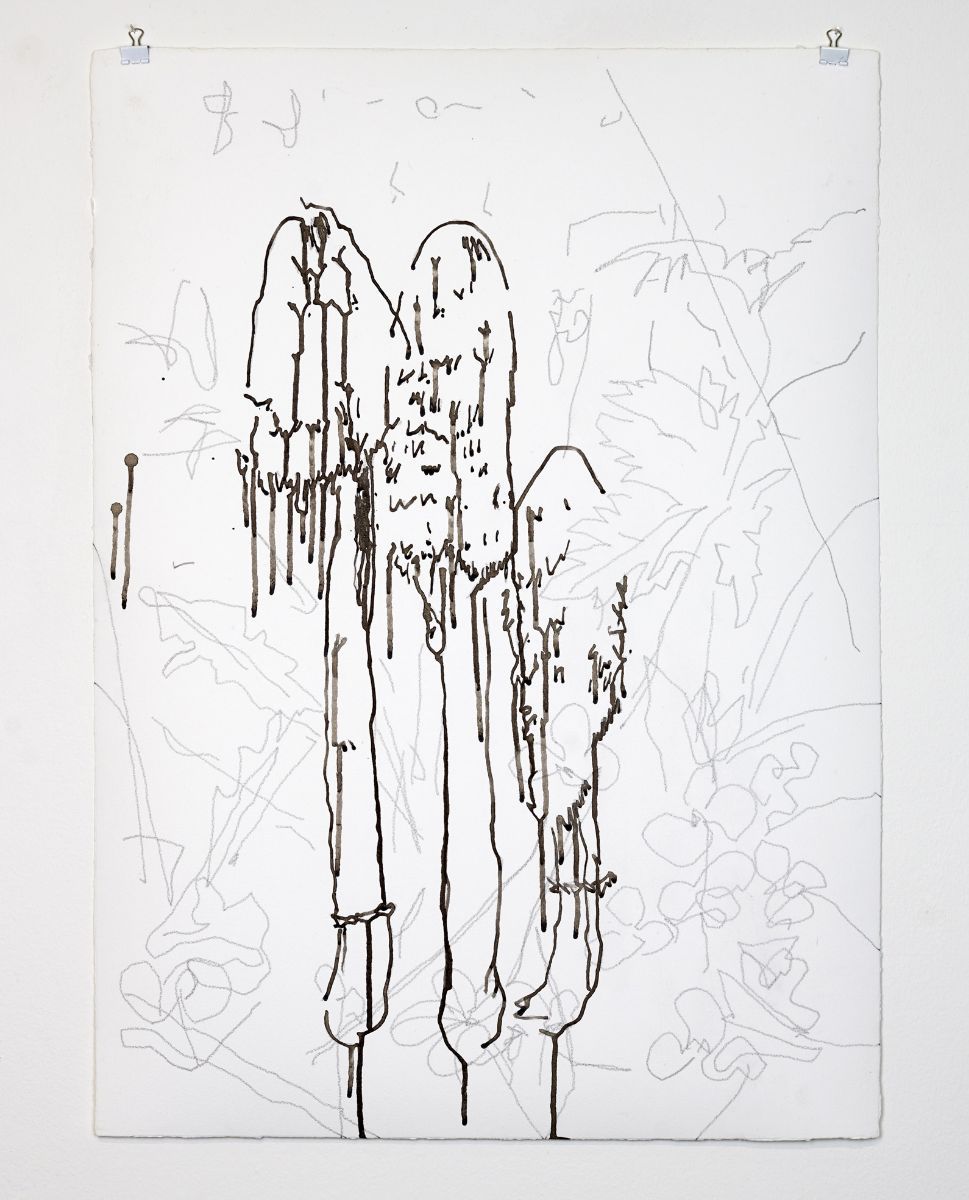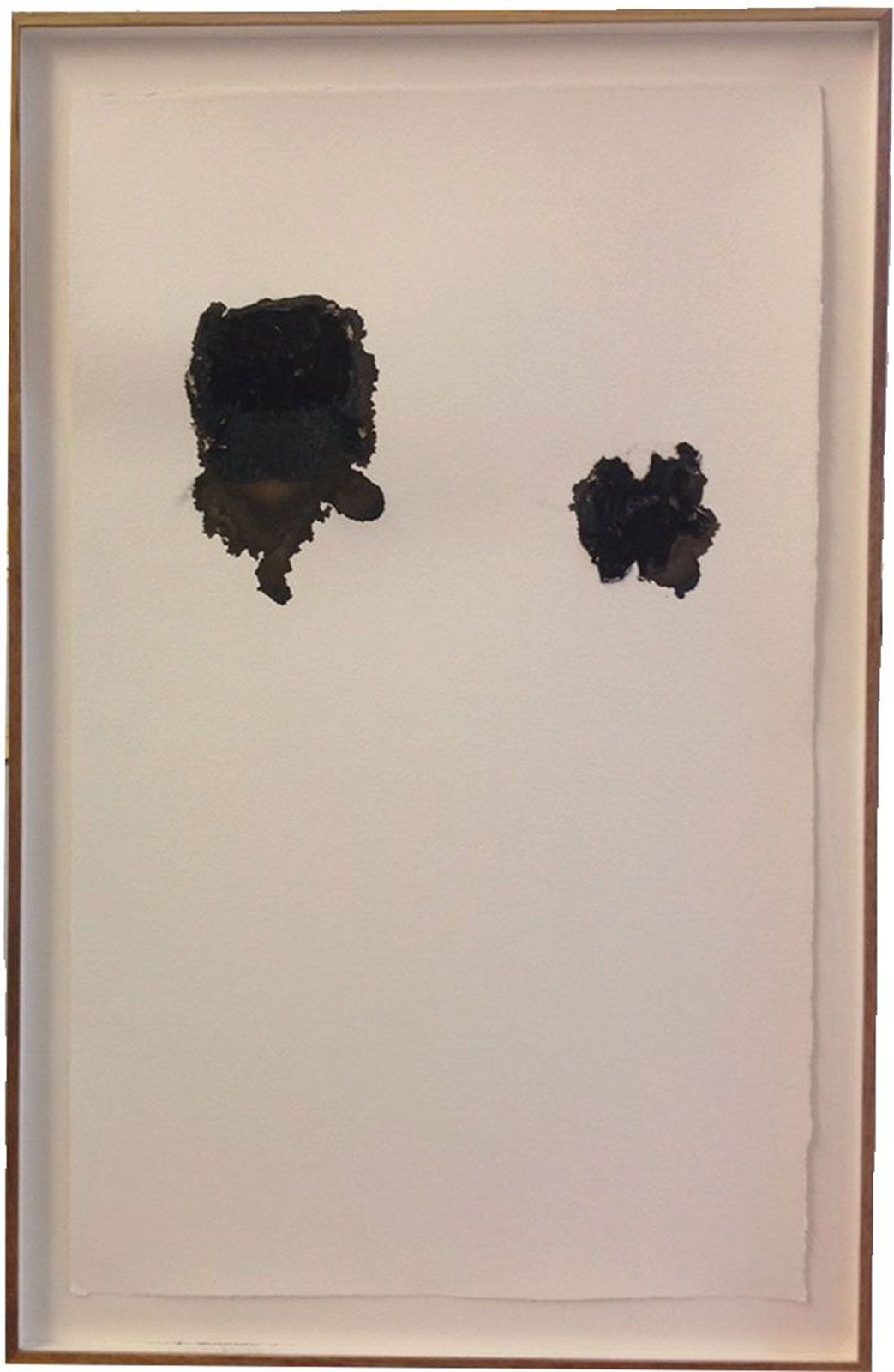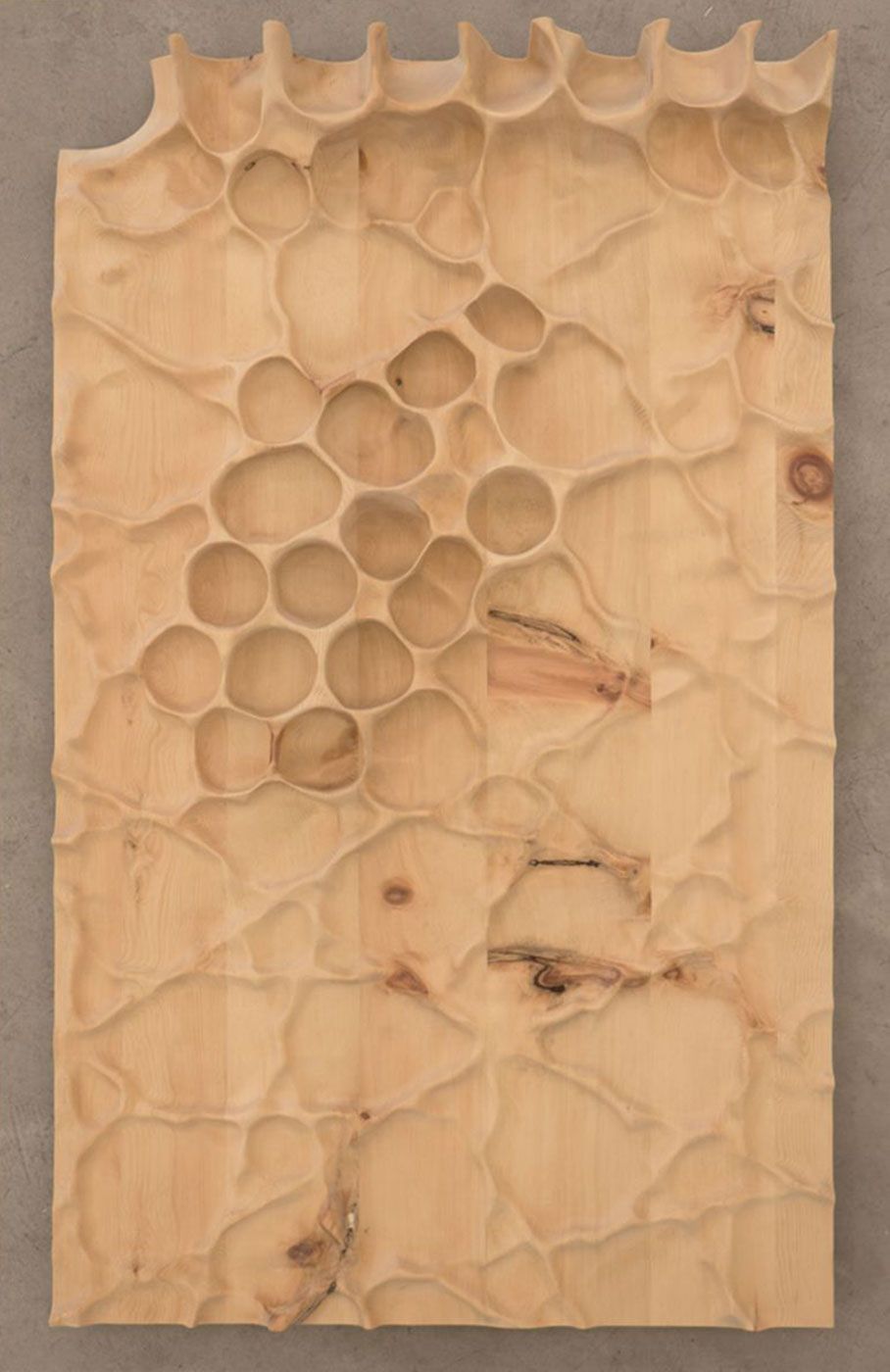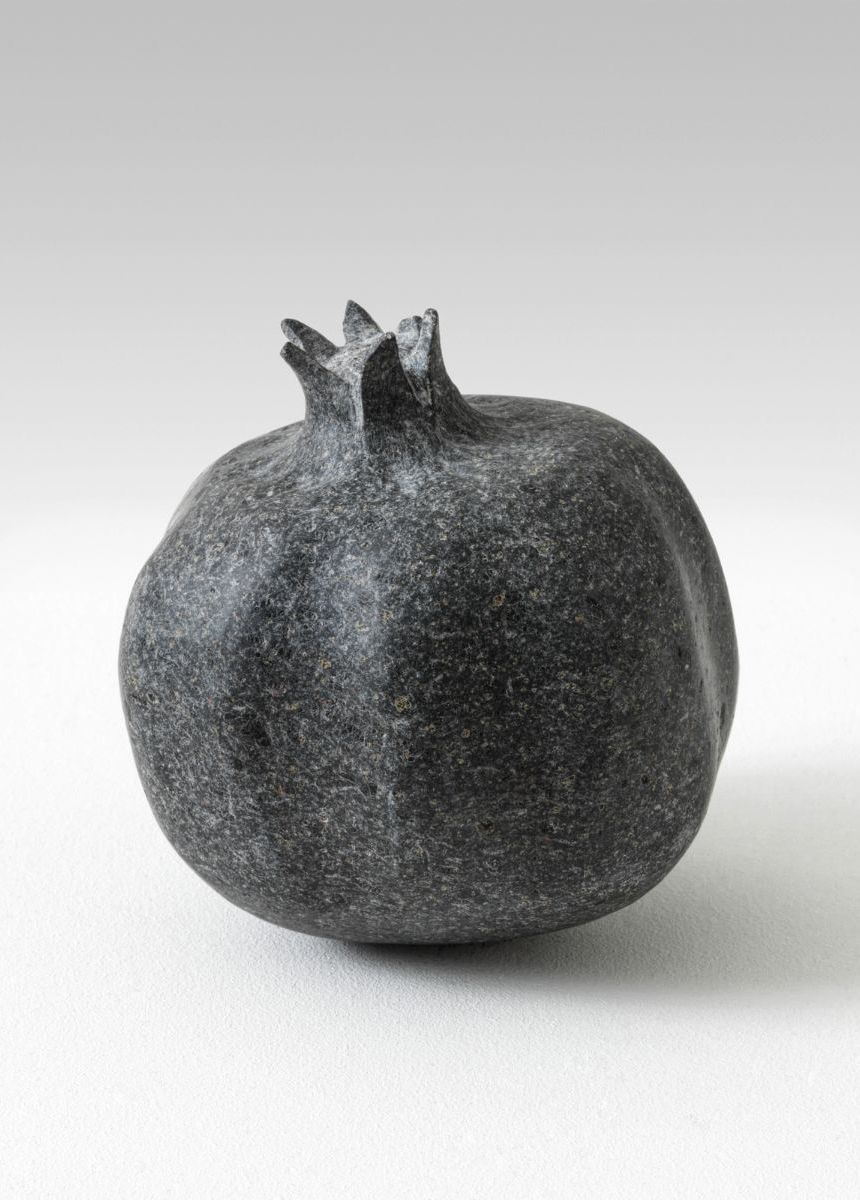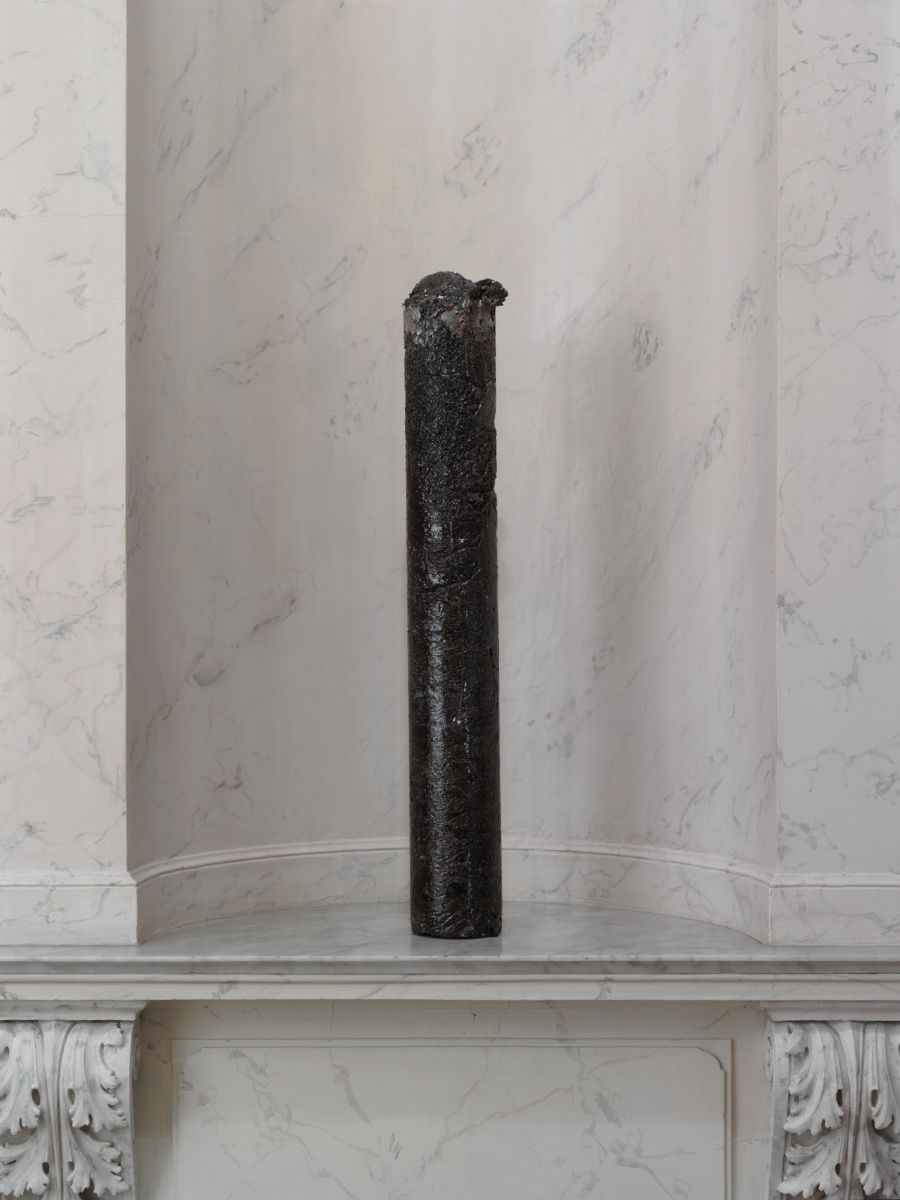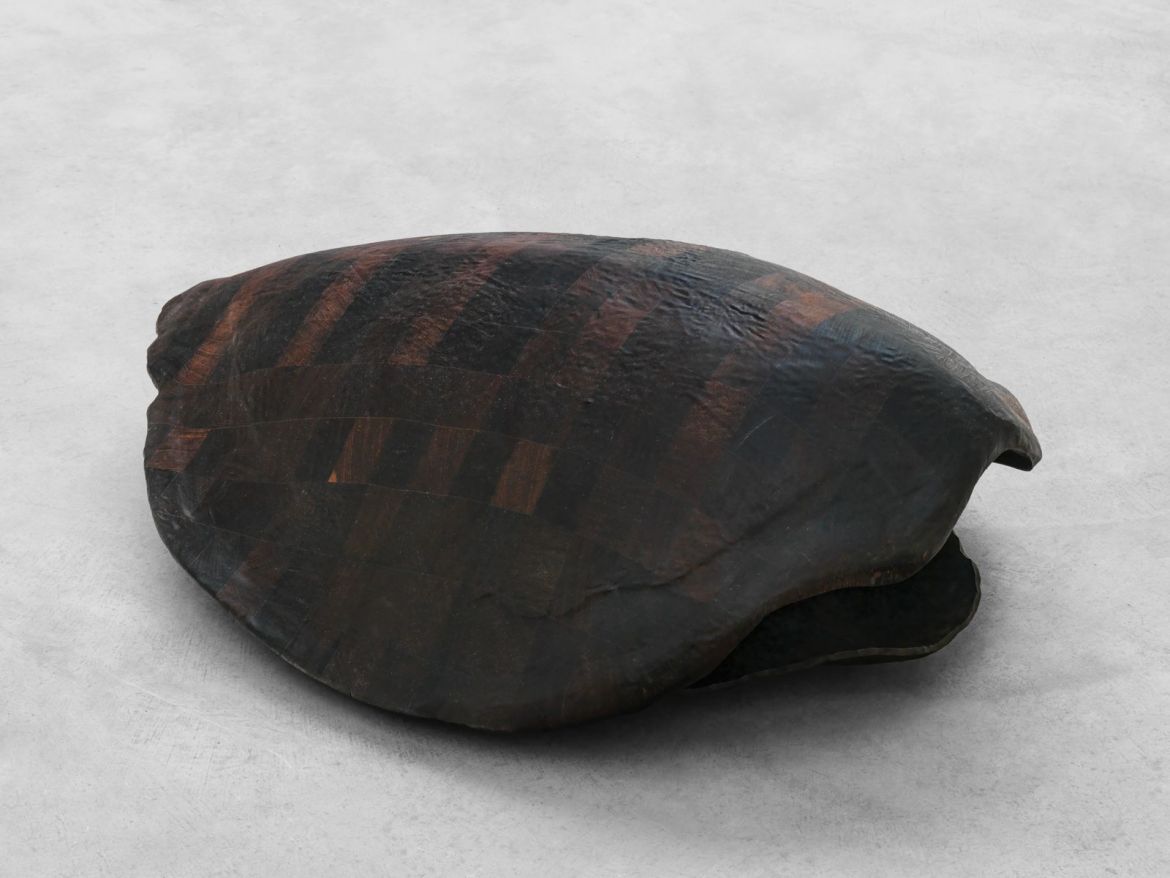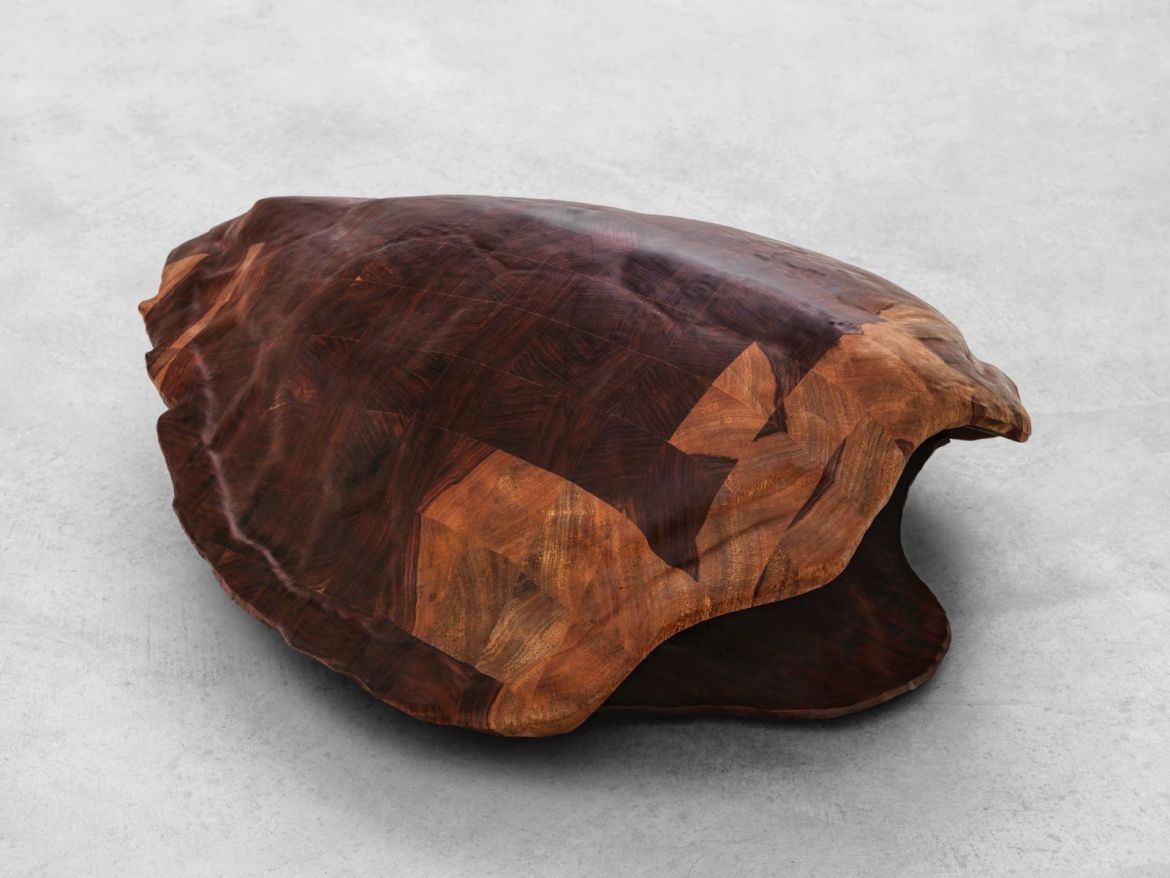Online Viewing Room
Mirko Baselgia
My studio is my microcosm, a space inhabited by objects that remind me of people and places and nourish my reflections. It is an extension of my mental universe and the natural context that surrounds me. It is a laboratory where I experiment with materials and substances and analyze processes and structures to create works that are an abstraction of the natural laws that govern our lives.
— Mirko Baselgia
Mirko Baselgia
Little Black, 2019
burnt larch wood, linseed oil
77 x 55 x 2.2 cm
Little Black is an abstract relief made of shingles of burnt larch wood nailed on a wooden panel. The larch veneers have been sawn into shape, burnt on both sides, brushed, and oiled twice. The shingles have been burnt following the Japanese Shou-Sugi-Ban process, as some facades in Japan are. But the use of wooden shingles also recalls the wooden shingle roofs and walls traditionally used in various regions of the world, namely in Switzerland and especially in the Grisons. Baselgia's interest in the issues related to skin is at the core of this work and scanning electron microscope (SEM) images of animal skins, such as fishes or butterflies, have served as inspiration to create the dynamic composition. Like skin, this wooden relief breathes, moves, lives and our eyes wish to contemplate, penetrate this mysterious black hole.
Mirko Baselgia
Selfportrait - reflecting on my inner dragon, 2019
lead, wood
77 x 55 x 2.2 cm
Self-portrait - reflecting on my inner dragon is an abstract relief that inaugurates a new phase in Mirko Baselgia's work. He didn't want to be the artist without studio any longer and he is more and more using his own hands to create new artworks. This self-portrait, which has been made with rests of a former work, shows Baselgia's interest in the issues related to skin, as well as his need to reflect on his own life, identity, and inner self. The artist's almost meditative act of juxtaposing the lead scales can be seen as a metaphor of the idea of slowly getting in touch with his imaginary inner dragon. This dragon symbolizes his subconscious fears and shadows and approaching, touching it is like a test that gives access to a deeper self-knowledge. By making it visible, the artist unveils his innermost being. As for the visual result of this process, the abstract feature of the work addresses the viewer's imagination that can interpret it in many different ways and maybe also feel the need to reflect on his own inner dragon.
Mirko Baselgia
Landscape of growing II, 2017, 1/1 AP
bronze, dark patina
77.5 x 56 x 5 cm
edition of 3 + 1 AP
The bronze relief Landscape of growing II deals with the principle of growth and the issues related to skin. Can growth – also in a figurative sense – be made visible in a sculpture? Baselgia works on this question within bronze castings he made from the bark of a sort of fast growing tree he found in Beijing. He noticed that trees there grow so fast that their bark rips open and that they created sort of landscapes on the surface of the trees that reminded him of the folds of the mountains and valleys at home, in the Alps. This work addresses the manifestations and survival strategies of nature in the hostile environment of a megacity. The artist cast the shape in bronze, the same material the first Chinese artifacts were traditionnally made of, like Shang dynasty ritual bronzes. Wherever he lives and works, be it close to nature in the mountainous regions of Switzerland or in totally different environments like the Chinese capital, Baselgia creates distinctive expressions of the circumstances he finds himself in.
Mirko Baselgia
Endoderm (marmot burrows), 2012 - 2013, 1/3
bronze (corner piece)
ca. 150 cm, ø 40 cm
edition of 3 + 1 AP
What seems to be a tree brunch or the representation of a neurological structure is actually a bronze reproduction of a marmot burrow. Satisfying a childhood curiosity of the artist for these animal architectures, this series of works also represents a personal exploration of the underground world and, more widely, it symbolizes the discovery of hidden mysteries, of realities that are beyond the visible. Baselgia chose the title Endoderm because the shapes of the burrows reminded him of the skin parts, endoderm and ectoderm, created in the embrionic process, called endoderm and ectoderm. This series is the sculptural correspondent of Alice I, a video filmed inside a marmot burrow and is the fruit of some lucky coincidences. After a two-week observation, the artist could choose, among some burrows that were about to be destroyed for the construction of a road near the Julierpass, the best one to be reproduced. Thanks to the collaboration with more than sixty people, it has been possible to create a concrete positive model of the underground tunnels and to realize the mould for the final bronze casting.
Mirko Baselgia
Rascha, 2015
Swiss handwoven linen from the Tessanda Val Müstair, spruce resin (Lantsch/Lenz), spruce wood
44 x 33 cm
Handwoven canvases from the local Tessanda Val Müstair are stretched on frames realized by the artist with spruce wood he found in his region. The same tree also offered him the resin he spread on the canvases in many layers after having given it a liquid consistency. A patchwork of many pieces of fabric or minimalist landscapes gently suggested by a horizontal line make up the series Rascha, a contemporary reflection on the traditional medium of painting. The canvas is not a mere support for an image, but it is a representation, an artwork in itself. Its materiality is highlighted and investigated with the desire to propose an alternative and personal idea of painting. Baselgia's aim is to transpose the concept of ecosystem in artworks by using only materials coming from the same region to create his paintings.
Mirko Baselgia
Albula, 2018
Swiss handwoven linen from the Tessanda Val Müstair, stone pine wood fallen in Val Tuors forest, tempera with a chicken egg from Alvaneu and pigments from the river Albula, Swiss linseed oil
77 x 55 x 2.2 cm
Following the series Rascha, the series Albula also deals with the idea to materialize the concept of ecosystem by creating paintings that are realized only with materials coming from the same region. For these monochrome paintings the artist created tempera with a local chicken egg and natural pigments he found in the river Albula. The canvas is handwoven by the traditional weaving mill Tessanda Val Müstair and the frame is of local stone pine wood.
Mirko Baselgia
Autolyse - Coprinus Comatus, 2018
drawing, pencil, ink out of the Coprinus Comatus, handmade paper from Papiermühle Basel
77 x 55 cm
Each drawing of the first series Autolyse - Coprinus Comatus represents one or more Coprinus Comatus, common fungi also known as “shaggy manes” or “inky caps” because of the unusual method they use to distribute their spores. Indeed, this type of fungi digests its own cap, which contribute to the dissemination of the spores. As auto-digestion - Autolyse - takes place, the cap and gills change into a black, gooey liquid, or ink. Self-destruction acquires here an unexpected positive meaning, allowing the growth of the next generation. Intrigued by this peculiar phenomenon, the artist went looking for these fungi in meadows. He first made drawings on site and then collected the fungi to extract their ink following an old recipe. Realized with pencil and the fungi’s ink, the drawings composing this series are analogical enlargements of the original sketches. The mushrooms are depicted in their natural environment to highlight the strong connection that these organisms share with their surroundings.
Mirko Baselgia
Autolyse - Coprinus Comatus, 2019
drawing, ink out of the Coprinus Comatus, handmade paper from Papiermühle Basel
54 x 33 cm; 60.5 x 38.5 x 2.5 cm (framed)
Following the more figurative first series of drawings, the second series Autolyse - Coprinus Comatus shows abstract inkblots left on the paper after the mushrooms' disintegration. Baselgia placed the mushrooms on the paper and gave the table a slope by lifting one edge of the table so that the ink could run down the sheet. Here the process of autolysis and gravity are the natural forces used by the artist to shape his drawings.
Mirko Baselgia
Midada da structura, 2019
pine-wood (pinus cembra)
110 x 68 x 11 cm
Midada da structura is the reproduction of a honeycomb that has undergone an experiment. The artist inserted in a beehive a wax base with an Islamic-inspired hexagonal pattern instead of a base with the traditional hexagonal design to see if it would influence the bees' work. The resulting honeycomb, which has actually been partly shaped by the unusual pattern, has then been enlarged and sculpted in Swiss stone pine wood with a digital machine. The intertwining of artificial and natural structures is thus the visual sign of the interaction between human and animal world. Bees are a recurring theme in the artist's creations; he's not only intrigued by their efficiency and precise hierarchical organization, which proves the closeness between the animal world and human society, but he also has a sort of emotional connection with these insects, since beekeeping is part of his familiar roots.
Mirko Baselgia
Purscheida, 2018, series of 6, Nr. 5
volcano stone from the Vesuvius eruption in 1944
(H) 11cm, Ø 11 cm
Purscheida - pomegranate in Rumantsch, the artist's mother tongue - refers to the underworld and its Greek goddess Persephone, a figure that embodies vegetal renewal and is commonly associated with spring. The myth relates that Persephone was gathering flowers when Hades abducted her and brought her to the underworld. As Demeter was profoundly shaken by the disappearance of her daughter, her husband Zeus ordered Hades to return Persephone. Faking to comply with Zeus’ request, Hades tricked Persephone by offering her some pomegranates seeds. For Persephone had tasted the food of the dead, Hades condemned her to spend a third of the year – the winter months – underground. The myth actually explains the origins of the cycle of seasons: when Persephone and her mother Demeter are reunited, the Earth flourishes, whereas winter comes back when she goes back to Hades. This black fruit is the reproduction in original size of a pomegranate sculpted into volcanic stone, debris collected by the artist in the vicinity of the Vesuvius and left by the last eruption of 1944. The choice of materials was dictated by the underground origin of the stone, which underwent a profound chemical transformation as liquid magma erupted from the bowels of the earth. If the pomegranate symbolizes temptation in the Greek myth, this one is still intact, leaving Persephone with the possibility of a choice and the hope that she could change her destiny.
Mirko Baselgia
Trivialization Zylinder, 2013
Exhibition view - Bündner Kunstmuseum Chur 2013
First Experiment
Lava del Vesuvio
(H) 77 cm, Ø 11 cm
Trivialization Zylinder is an imperfect cylinder made from recast Vesuvius lava. Confronted with the impossibility of realizing his childhood idea of taking liquid lava from an active volcano and putting it directly into a mould to make a sculpture, Baselgia was content to obtain solidified lava from Vesuvius to realize his project. With the help of the Fonderia Nolana Del Giudice, he carried out a first experiment to recast the solidified lava, a process that generated a different material from the original one, almost glassy and usable only for the realization of simple and regular shapes. The complexity of the organic structure of solidified lava is thus simplified in a banal cylinder, which becomes a sort of symbol of our widespread need for trivialization and simplification of natural complexity in the understanding of the world around us.
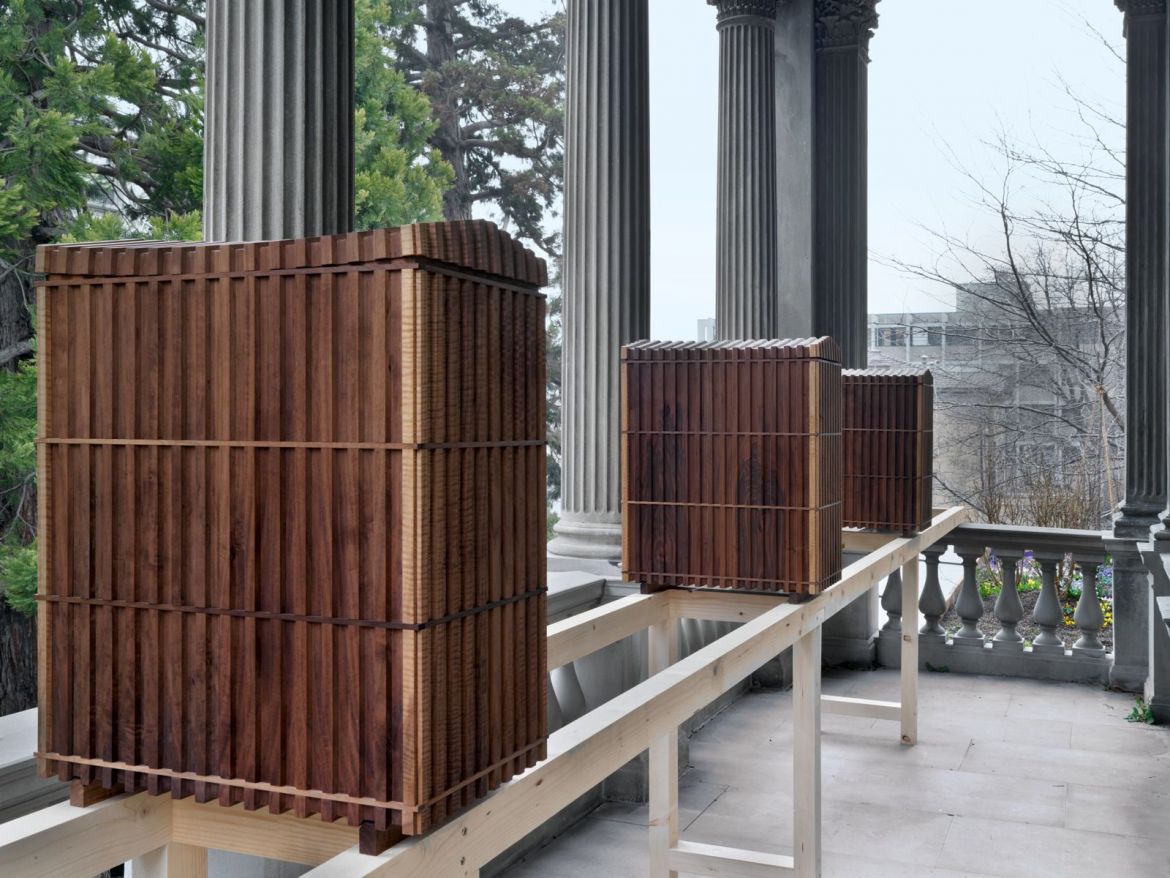
Mirko Baselgia
Domus Apis Melliferae et Domesticae, 2013
Exhibition view - Bündner Kunstmuseum Chur 2013
European walnut, walnut oil, linseed oil
each 77 x 55 x 33 cm
Domus Apis Melliferae et Domesticae is a series of three sculptural beehives. Working with the ideas of minimal art and architectural models, the artist has created these pieces in precious European walnut wood to elevate these simple architectures and give them a homey appearance. These structures were actually home to bees throughout the period of an exhibition in Chur in 2013, where they were installed under the colonnade of the Kunstmuseum.
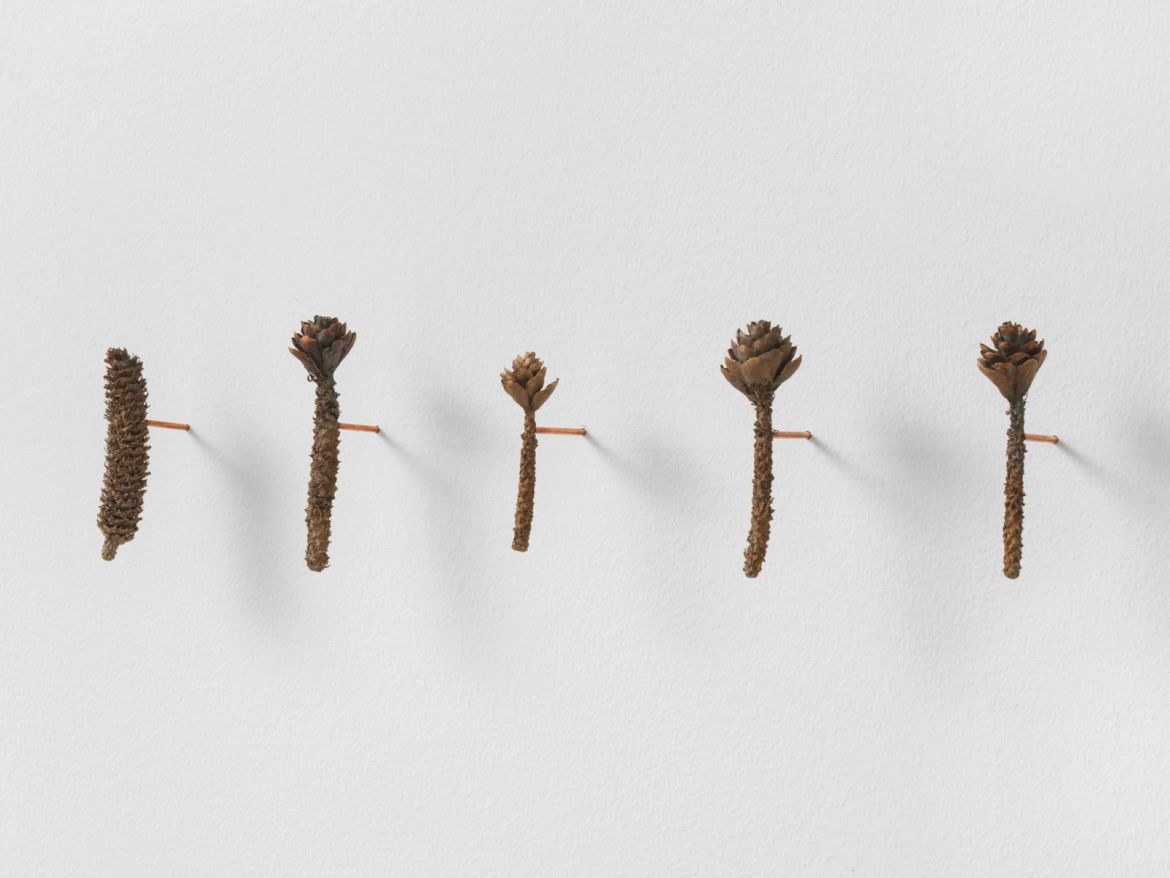
Mirko Baselgia
Las flours digl gôt - Sciurus, 2018, 5/5
red bronze
11 x 22 x 5.5 cm
edition of 5 + 1 AP
Las flours digl gôt - Sciurus are red bronze reproductions of five gnawed pinecones that the artist found during one of his walks in the woods. The pinecone on the left is different because it was eaten by a bird, while the others were all gnawed by squirrels. Baselgia is fascinated by the way these rodents manage to extract the seeds from the pinecones to feed themselves. They remove one by one the scales that cover the pinecones and thus create structures that resemble flowers. By eating their seeds, the squirrels also give the trees the chance to walk and ensure their reproduction. Nailed to the wall horizontally next to each other, the five cones reproduced on a natural scale form an unusual bouquet of flowers, but also an intriguing group portrait.
Mirko Baselgia
Tartaruga, 2018
wenge
31 x 98 x 76 cm
SALES INQUIRY
Many of Mirko Baselgia’s works are directly inspired by natural structures, which have been reworked in an unexpected material, giving them new aesthetic value and meaning. This is the case of the series of sculptures Tartaruga, wooden reproductions of real turtle shells conservated in a natural history museum. Of variable dimensions, they are made of seven different African wood species and are empty. The artist imagined them as metaphors of the thousands of human beings who lost their lives in the Mediterranean Sea these last years.
Mirko Baselgia
Tartaruga, 2018
bubinga
24.5 x 77.5 x 65.5 cm
SALES INQUIRY
Drawing a parallel between the environmental issues and the overfishing threatening the turtles' life and the tragedy of the current migrant crisis, he raises moral and ethical questions and suggests the necessity to find more humanistic and effective solutions. This series was originally conceived for the solo exhibition Pardis (Curzoin) at Bellelay Abbey (2018), where the eleven turtle shells were disseminated just below the Agnus Dei fresco in the apsis, corroborating the idea of sacrifice.
ARTIST INFORMATION
For more information about the artist please click here.
PHOTOS
By Stefan Altenburger und Jürg Zimmermann (Portrait).

